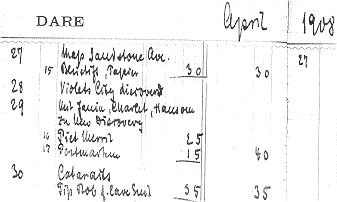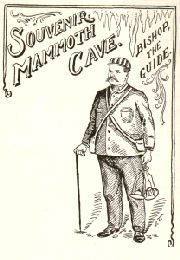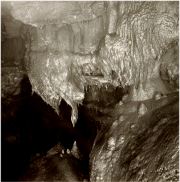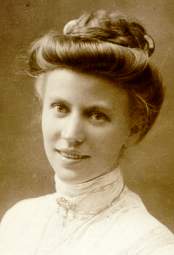genealogy
Index
Part 1
Part 2
Part 3
Part 4
Part 5
Part 6
Part 7
German
Audiofile
on this part
(German)
The black box
The Kaemper family became infected by our "Searching for Max" and has looked for further documents. A box emerges. The widow had kept yellowed souvenirs of her husband in it.
 We open an envelope and see cave photos.
Pictures, taken by Max in 1908
of his discoveries in Mammoth Cave. We recognize
the characteristic dripstone cascades of Violet City.
We see pictures of canyons and rivers.
The quality of the pictures is amazing. They are skillfully
illuminated by magnesium light and perfectly printed.
We open an envelope and see cave photos.
Pictures, taken by Max in 1908
of his discoveries in Mammoth Cave. We recognize
the characteristic dripstone cascades of Violet City.
We see pictures of canyons and rivers.
The quality of the pictures is amazing. They are skillfully
illuminated by magnesium light and perfectly printed.
Full of excitement we open a black notebook. The large surprise: it contains entries of Max Kaempers journey to America. It´s not a diary in the strict sense of the word, rather a cashier´s journal. Day for day Max noted with the utmost care his expenses and incomes. Sometimes he added small comments.

Day for day, location for location, Max´s activities in America can be reconstructed. The shape of a real person emerges.
With 750 Marks fare in the bag and 155 pounds of luggage he leaves Berlin at the end of of April, 1907. Via Munich and Milano he travels to Genova where he embarks the "Norddeutscher Lloyd" mail-boat "Friedrich der Grosse". The passage costs 400 Marks. On May, 16 he arrives in New York.
Max has some problems to adjust himself to the bubbling, booming town. He writes many letters to his family. One of them outlasted the time.
"According to his letters he had great adjustment problems, mainly with the behaviour of the people."
"He writes: What Americans call liberty and equality we would define as rudeness. Perhaps I will get used to it in the course of time. It´s mainly the behaviour in the restaurants. Something like this does not exist at home. I would bet that a German student who in Berlin tried to behave himself in an "American" way only one day long, would get a dozen challenges to duel. But we are not in Berlin here."
But quite quickly Max begins to enjoy New York. The days of the young engineer are devoted to the art of engineering. The evenings and weekends to arts and music. He visits museums, concerts and theatres. No important premiere which he omits. He listens to all the stars of his time in the concert halls. In the Metropolitan Opera in 1907 the tenor Enrico Caruso triumphs. Max sits in the auditorium when technicians record the event for future generations on Edison cylinders.
Max moves to the heart of the theatre quarter, where Madison Square is located today. He takes violin courses and meets with friends for playing music.
Almost each week he buys new notes: the current hits of the turn of the century as well as Beethoven´s violin sonatas and other classical works.
In February of 1908 he leaves New York and starts for a journey to the American industrial areas. In Pittsburg he visits several steel plants - on recommendation of his uncle Heinrich Lueg, one of the steel barons in the Ruhr district. The entries in the notebook are scarce, the visits hardly more than rapidly finished duty exercises.
For the target of his journey is situated in the south: in the most remote part of Kentucky, in the hills close of a tiny sleepy small town named "Cave City".
At the end of February 1908 he arrives at Mammoth Cave. An uncomfortable season for a visit. The hotel: badly heated and quite shabby. The weather cloudy, the trees bald. In winter times not an inviting region at all.
We ask ourselves what may have caused him to undertake this journey. In his notes there is no hint that this trip had been planned beforehand. There is not the smallest indication that Max was interested in caves at all. But now - for whatever reasons - he had arrived here.
 Black guides take him along the routes which the tourists
usually are shown at that time.
After two days he has seen the standard
program and could have left. But the cave has fascinated him.
He wants to see more of this gigantic labyrinth,
including the galleries outside of the touristic routes.
He wants to go where only few have been before.
And he wants to go even further inside the mountain, into
new, unknown passages which nobody entered before.
Black guides take him along the routes which the tourists
usually are shown at that time.
After two days he has seen the standard
program and could have left. But the cave has fascinated him.
He wants to see more of this gigantic labyrinth,
including the galleries outside of the touristic routes.
He wants to go where only few have been before.
And he wants to go even further inside the mountain, into
new, unknown passages which nobody entered before.
The black guide Ed Bishop takes Max to the most remote area of the cave. The trip takes several hours. At the end of a canyon they reach the point where some years before a guest from New York had turned around. A pit in the floor blocks the way.
Max and Ed climb over the obstacle and discover a
dripstone decorated chamber from which further
black openings lead into the unknown.
 Max calls the pretty chamber " Gertas Grotto".
Two days later the two men
are again in the cave, in order to draw a map of their discovery.
Now at last, the engineer is infected by the cave virus.
Day after day he is now underground with Ed Bishop, drawing and
measuring. His ambitious, almost unattainable target: he wants to
explore the whole system of Mammoth Cave systematically up to
the most remote parts and he wants to draw a complete map of the
largest cave in the world.
Max calls the pretty chamber " Gertas Grotto".
Two days later the two men
are again in the cave, in order to draw a map of their discovery.
Now at last, the engineer is infected by the cave virus.
Day after day he is now underground with Ed Bishop, drawing and
measuring. His ambitious, almost unattainable target: he wants to
explore the whole system of Mammoth Cave systematically up to
the most remote parts and he wants to draw a complete map of the
largest cave in the world.
In his note book he writes down briefly on which day which cave section is on the schedule. Max and Ed work fast and precise. Mile after mile is mapped with tape and compass. Max knows what is to be done: in the army he had learned, as an artillery lieutenant, to deal with maps and measuring points.
The two men must have been in a very good physical condition because the way to the most remote sections of the cave was a long, long trip. Surely some of their underground trips took more than 24 hours.
In his hotel room Max must have spent long nights drawing and calculating. But beside all this he still has time for an active social life. He is invited to family celebrations. Accompanied by a young lady at the pianoforte he even gives a concert in the cave hotel which is well accepted in the local newspaper.
The handsome guest from Germany must also have pleased the upper class daughters of the region because they even do not hesitate to accompany Max on some of his cave trips. Max shows gratitude and give Lida and Becky and Maymie a little bit of immortality by naming galleries after them: Lida´s pass..., Becky´s Alley..., Maymie´s stoop
But the woman who is obviously most important for him lives on the other side of the Atlantic: Gerta. After her he named his first discovery. And her name marks also the end of its notes:
"Message of Gerta´s engagement " is written there, in a somewhat smeared writing. Some days later the recordings end.
 Who was Gerta?
Who was Gerta?
Mrs. Kaemper, the daughter-in-law of Max, had the answer:
"Gerta was a cousin, with whom he also made music /... / they were probably youth friends /.. / and I think he also adored her."